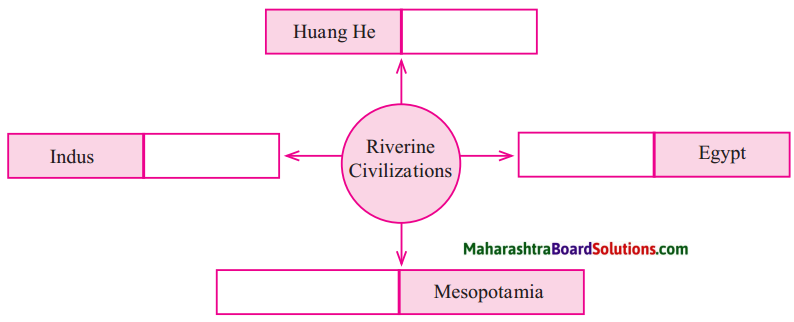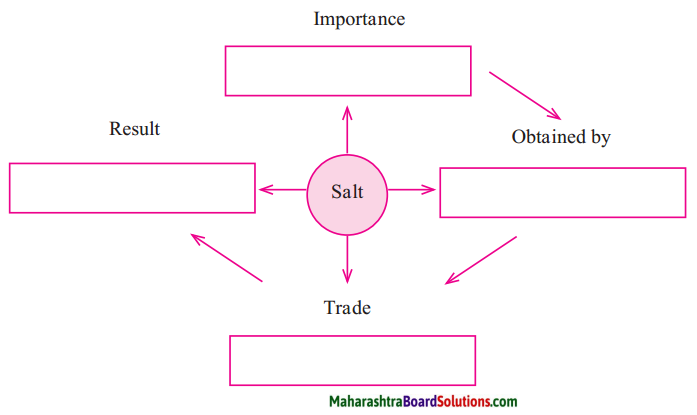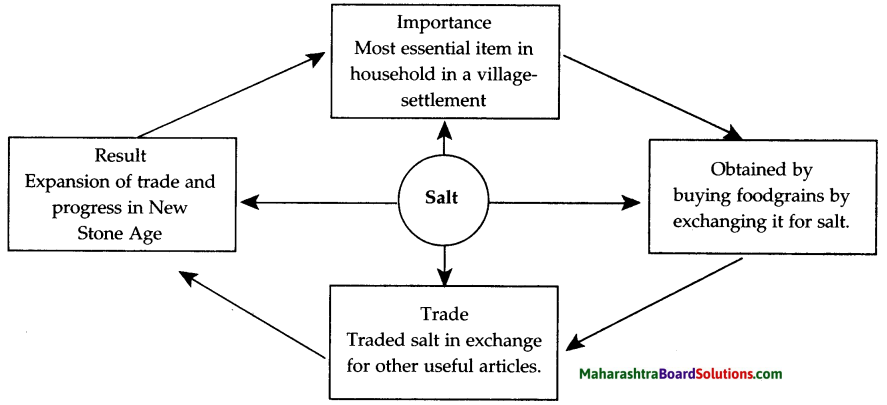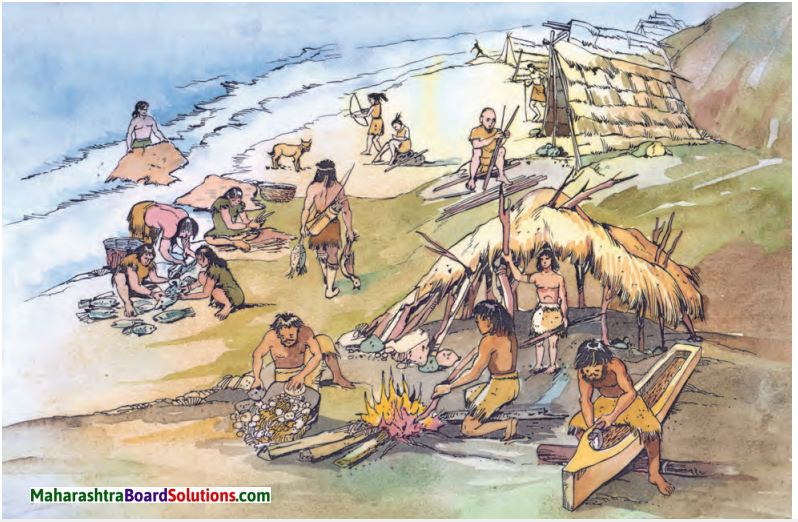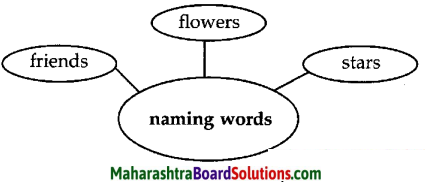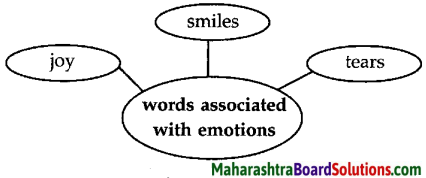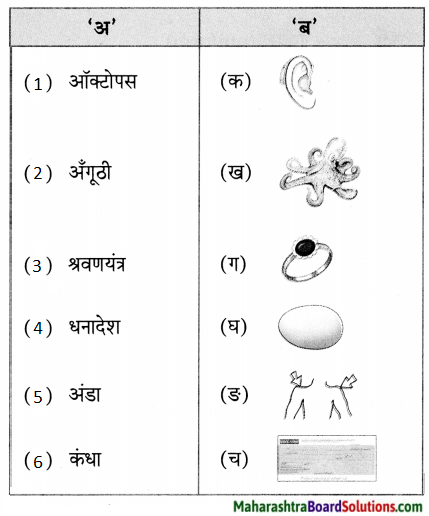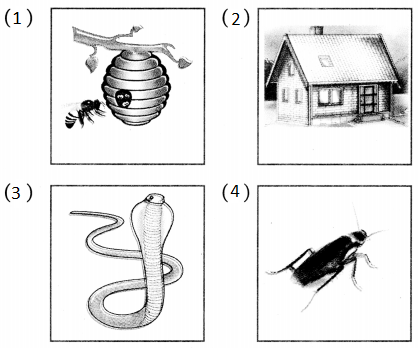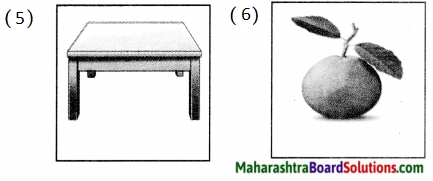Balbharti Maharashtra State Board Class 5 Environmental Studies Solutions Chapter 19 Constituents of Food Notes, Textbook Exercise Important Questions and Answers.
Maharashtra State Board Class 5 EVS Solutions Part 1 Chapter 19 Constituents of Food
5th Std EVS 1 Digest Chapter 19 Constituents of Food Textbook Questions and Answers
1. What’s the solution?
Question 1.
The body requires adequate quantity of protein.
Answer:
To meet the requirement of protein necessary for our body, we should consume protein rich food. We should include foods like, eggs, meat, fish, pulses, beans and dairy products like cheese, milk, yoghurt etc. in our diet. Vegetarian people should include at least one cup (katon) of dal daily in their diet as that is the only source of protein in their diet.
![]()
2. Use your brain power!
Question 1.
Why are children told to drink milk everyday?
Answer:
Children are growing tall and hence their bones are also growing. Calcium is needed for strong bones. Hence children need to get large amounts of calcium, for proper growth of bones. Milk is a source of calcium which can supply the required amount of calcium necessary for growth of bones. Therefore children are told to drink milk everyday.
3. Give two sources of each of the following constituents:
Question 1.
Give two sources of each of the following constituents:
Answer:
| Constituents | Examples of Sources of food |
| (a) Minerals | (1) Milk (2) Green leafy vegetables |
| (b) Proteins | (1) Egg (2) Pulses |
| (c) Starch | (1) Potato (2) Jowar |
4. Fill in the blanks:
Question (a)
………………….. in our food give us the ability to resist diseases.
(a) proteins
(b) vitamins
(c) fats
Answer:
(b) vitamins
![]()
Question (b)
Calcium makes our bones …………………… .
(a) strong
(b) weak
(c) smooth
Answer:
(a) strong
Question (c)
Food stuff that taste sweet contain various kinds of ……………….. .
(a) sugars
(b) jaggery
(c) honey
Answer:
(a) sugars
Question (d)
A diet that provides all the constituents of food in the right proportions is called a …………….. diet.
(a) irregular
(b) regular
(c) balanced
Answer:
(c) balanced
5. Answer the following questions.
Question (a)
Of what use are the sugars that we get from the digestion of starch?
Answer:
The sugars obtained from digestion of starch bum slowly in our body and release energy which is necessary for doing various works.
Question (b)
Name the sources of fibre in our diet.
Answer:
Sources of fibres in our diet are cereals, like wheat, jowar, bajra etc. from which we make chapati or bhakari and all the fruits and vegetables that we eat.
Question (c)
What are carbohydrates?
Answer:
Constituents of food like starch, fibres and sugars that provide energy to our body are called carbohydrates.
![]()
Question (d)
What is meant by malnutrition?
Answer:
Our diet should supply various constituents like carbohydrates, proteins, fats, viatmins and minerals in the right proportion for proper nourishment and growth. If the diet taken lacks in some constituents over a long period of time, the person does not get proper nourishment. This leads to a condition called malnutrition . Malnutrition has serious consequence on health. Lack of sufficient quantities of proteins and carbohydrates lead to stunted growth.
6. Match the following:
Question 1.
Match the following:
| Column ‘A’ | Column ‘B’ |
| 1. Fats | (a) Jowar |
| 2. Proteins | (b) Oil |
| 3. Vitamins | (c) Bran of cereals |
| 4. Minerals | (d) Pulses |
| 5. Starchy foods | (e) Iron |
Answer:
| Column ‘A’ | Column ‘B’ |
| 1. Fats | (b) Oil |
| 2. Proteins | (d) Pulses |
| 3. Vitamins | (c) Bran of cereals |
| 4. Minerals | (e) Iron |
| 5. Starchy foods | (a) Jowar |
Environmental Studies Part 1 Standard 5th Solutions Chapter 19 Constituents of Food Additional Important Questions and Answers
Fill in the blanks with the correct answers from the options given below:
Question 1.
Starch turns blackish blue when it comes in contact with ………………… solution.
(a) sodium
(b) calcium
(c) iodine
Answer:
(c) iodine
![]()
Question 2.
Cereals like jowar, bajra, wheat, rice contain a lot of ………………. .
(a) starch
(b) protein
(c) vitamin
Answer:
(a) starch
Question 3.
When the starchy foods we eat are digested …………………. are formed.
(a) chocolate
(b) sugars
(c) fuel
Answer:
(b) sugars
Question 4.
Sugars formed by the digestion of starch act as ………………… of our body.
(a) strength
(b) fuel
(c) muscles
Answer:
(b) fuel
Question 5.
Fibre is also called …………………. .
(a) muscles
(b) fruits
(c) roughage
Answer:
(c) roughage
Question 6.
If our diet does not contain enough fibre, it can lead to ……………….. .
(a) constipation
(b) vomiting
(c) fever
Answer:
(a) constipation
Question 7.
……………… deposited under the skin prevents loss of heat from the body.
(a) Fats
(b) Oil
(c) Muscles
Answer:
(a) Fats
Question 8.
…………………. are known as the building blocks of our body.
(a) Vitamins
(b) Proteins
(c) Carbohydrates
Answer:
(b) Proteins
![]()
Question 9.
Night blindness is caused due to lack of …………………… .
(a) vitamin D
(b) vitamin A
(c) vitamin B
Answer:
(b) vitamin A
Question 10.
Deficiency of ……………….. leads to anaemia.
(a) calcium
(b) protein
(c) iron
Answer:
(c) iron
Question 11.
When a person does not get enough proteins and carbohydrates through their diet their growth is ………….. .
(a) increased
(b) decreased
(c) stunted
Answer:
(c) stunted
Question 12.
Sago and sweet potato contain …………………… .
(a) starch
(b) protein
(c) carbohydrates
Answer:
(a) starch
Question 13.
Cereals like jowar, bajra, wheat, rice contain a lot of ………………… .
(a) protein
(b) starch
(c) fuel
Answer:
(b) starch
Question 14.
We get …………………. from starchy foods.
(a) fuel
(b) energy
(c) sugar
Answer:
(b) energy
Question 15.
Our body uses energy for different kinds of …………………. .
(a) food
(b) fuel
(c) work
Answer:
(c) work
![]()
Question 16.
Wheat is ground into a ………………… .
(a) fuel
(b) paste
(c) flour
Answer:
(c) flour
Question 17.
Bran is a …………………. substance.
(a) fibrous
(b) starchy
(c) sticky
Answer:
(a) fibrous
Question 18.
In the process of digestion, fibre has a function.
(a) festive
(b) special
(c) delicious
Answer:
(b) special
Question 19.
……………………. helps to form stool from undigested food.
(a) Protein
(b) Sugar
(c) Fibre
Answer:
(c) Fibre
Question 20.
Oil is a ………………. substance.
(a) fatty
(b) sugary
(c) fibrous
Answer:
(a) fatty
Question 21.
Paper becomes ………………… when a fatty substance is applied to it.
(a) pulpy
(b) translucent
(c) sticky
Answer:
(b) translucent
Question 22.
Fats in our food provide ……………… to our body.
(a) energy
(b) starch
(c) sugar
Answer:
(a) energy
Question 23.
Fats give …………………. as much energy as carbohydrates.
(a) once
(b) twice
(c) thrice
Answer:
(b) twice
![]()
Question 24.
The fats we eat get …………………. in our body.
(a) used
(b) digested
(c) stored
Answer:
(c) stored
Question 25.
The ………………….. undergoes wear and tear continuously.
(a) body
(b) mind
(c) soul
Answer:
(a) body
Question 26.
Malnutrition has serious …………………. for the person’s health.
(a) essentials
(b) viruses
(c) consequences
Answer:
(c) consequences
2.
Question (A)
Match the following:
| Column ‘A’ | Column ‘B’ |
| 1. Iron deficiency | (a) Weak and brittle bones |
| 2. Calcium deficiency | (b) Malnutrition |
| 3. Vitamin A deficiency | (c) Weak bones and teeth |
| 4. Vitamin D deficiency | (d) Anaemia |
| 5. Proteins and Carbohydrate deficiency | (e) Night blindness |
Answer:
| Column ‘A’ | Column ‘B’ |
| 1. Iron deficiency | (d) Anaemia |
| 2. Calcium deficiency | (c) Weak bones and teeth |
| 3. Vitamin A deficiency | (e) Night blindness |
| 4. Vitamin D deficiency | (a) Weak and brittle bones |
| 5. Proteins and Carbohydrate deficiency | (b) Malnutrition |
Question (B)
Match the following:
| Column ‘A’ | Column ‘B’ |
| 1. Constituent of food giving energy | (a) Iron |
| 2. Costituent of food needed for repair | (b) Vitamins |
| 3. Constituent of food proetcting internal organs | (c) Proteins |
| 4. Constituents of food helping in resisting diseases | (d) Carbohydrates |
| 5. Constituent of food necessary to supply enough oxygen | (e) Fats |
Answer:
| Column ‘A’ | Column ‘B’ |
| 1. Constituent of food giving energy | (d) Carbohydrates |
| 2. Costituent of food needed for repair | (c) Proteins |
| 3. Constituent of food proetcting internal organs | (e) Fats |
| 4. Constituents of food helping in resisting diseases | (b) Vitamins |
| 5. Constituent of food necessary to supply enough oxygen | (a) Iron |
![]()
Question 1.
Give two sources of each of the following constituents:
Answer:
| Constituents | Examples of Sources of food |
| (a) Vitamin A | (1) Carrots (2) Papaya |
| (b) Calcium | (1) Milk, cheese (Dairy products) (2) brocoli (3) Leafy vegetables |
| (c) Fats | (1) Oils (2) Butter (3) Peanut |
| (d) Iron | (1) Meat (2) Spinach (palak) |
| (e) Vitamin C | (1) Lemon (2) Tomatoes (3) Sprouted pulses |
| (f) Sugars | (1) Fruits (2) Sugarcane |
| (g) Vitamin D | (1) Fish oil like (Cod liver oil) (2) egg yolk |
| (h) Vitamin B | (1) Nuts (2) Green leafy vegetables like spinach, broccoli etc. (3) cereals (wheat, millet) |
Answer the following in one or two sentences:
Question 1.
How will you detect the presence of starch in food?
Answer:
The presence of starch in food is detected by adding iodine solution. If the food turns bluish black then starch is present.
Question 2.
What is a balanced diet?
Answer:
A diet which provides all the constituents like, protein, carbohydrates, fats, vitamins and minerals in right quantities is called a balanced diet.
Question 3.
Which food constituents are necessary for normal functioning of various processes in our body and help in maintaining resistance to diseases.
Answer:
Vitamins and minerals are the food constituents which are necessary for normal functioning of various processes in our body and help in maintaining resistance to diseases.
Question 4.
Why are proteins called building blocks of our body?
Answer:
Proteins help in healing and repairing of our body which undergoes wear and tear continuously and it also helps in building muscles. Therefore they are called building blocks of our body.
![]()
Question 5.
Which mineral in necessary for carrying oxygen to different parts of our body?
Answer:
Iron is necessary for carrying oxygen to different parts of our body.
Question 6.
Which minerals and vitamin help to make our bones strong?
Answer:
Vitamin D and the mineral calcium makes our bones strong.
Question 7.
What do we obtain from cereals?
Answer:
We obtain flour from cereals like jowar, bajra, wheat and rice.
Question 8.
What is the sugar obtined from jaggery and table sugar called?
Answer:
Sugar obtained from jaggery and table sugar is called sucrose.
Question 9.
How does fibrous substance help in our digestion?
Answer:
Fibrous substances help the food to move forward in the alimentary canal at the right speed.
Question 10.
How is carbohydrates useful to the body?
Answer:
The most important use of carbohydrates is to provide the body with energy.
Question 11.
What happens if our food does not contain enough fibre?
Answer:
If our food does not contain enough fibre it can lead to constipation.
Question 12.
What does paper becoming translucent signify?
Answer:
Paper becoming translucent is a sign of the presence of fats in the food stuff kept on it.
![]()
Question 13.
Which food item contain fats?
Answer:
Cream, butter, ghee, oil, nuts, meat, egg, yolk contain fats.
Question 14.
Why does our body store the fats we eat?
Answer:
Our body store the fats we eat because if sometimes food is not available then it can get energy from the stored fats.
Question 15.
Where does the body store fats?
Answer:
The body stores fats in a layer under the skin.
Question 16.
How does fats under the skin help us?
Answer:
The fats under the skin gives shape to the body and like a blanket prevents loss of heat from the body.
Question 17.
How are our internal organs protected?
Answer:
The layer of fat in the body protects our internal organs, that is why, an injury from outside does not at once cause damage to our bones or other internal organs.
![]()
Question 18.
Why is protein required in our body?
Answer:
The healing and repair of the tissues in our body goes on all the time without us being aware of it. Proteins are necessary for this process.
Question 19.
Which food stuff contains protein?
Answer:
All the different daals, pulses, groundnuts, milk and milk products like yoghurt, khoya, paneer, eggs, meat and fish are rich sources of proteins.
Question 20.
What are macronutrients?
Answer:
Our body requires carbohydrates, fats and proteins in large proportions. These food constituents are called macronutrients.
Question 21.
What are micronutrients?
Answer:
We need certain food constituents in very small quantities. These are called micronutrients, e.g. vitamins and minerals.
![]()
Question 22.
Which vitamins are most important vitamins?
Answer:
Vitamin A, B, C, D, E and K are the most important vitamins.
Question 23.
Why do we need vitamins in our body?
Answer:
We need very small quantities of vitamins in . our body as lack of or deficiency of any vitamin
results in serious disorders.
Question 24.
What does deficiency of vitamin ‘A’ lead to?
Answer:
Deficiency of vitamin A leads to night blindness.
Question 25.
What does deficiency of vitamin D lead to?
Answer:
Deficiency of vitamin D results in weak and brittle2 bones.
Question 26.
Which minerals are essential for the body?
Answer:
Minerals like iron, calcium, sodium, potassium are essential for the body.
Question 27.
What is ‘anaemia’?
Answer:
If there is a deficiency of iron in the blood, the body does not get enough supply of oxygen and one feels constantly weak and tired. This condition is called ‘anaemia’.
![]()
Question 28.
What are the sources of vitamins and minerals?
Answer:
All kinds of fruits, vegetables, green leafy vegetables, sprouted, pulses, their skin and the bran of cereals and pulses are all sources of vitamins and minerals.
Question 29.
What is the requirement for our good health?
Answer:
For good health, our body should get all the different constituents of food, namely, carbohydrates, proteins, fats, vitamins and minerals in the right quantities.
Question 30.
What happens when a person does not get enough carbohydrates and proteins?
Answer:
If a person does not get enough carbohydrates and proteins, their growth gets stunted, he feels constantly tired and cannot cope with his studies, games or other tasks.
Give reasons:
Question 1.
We should eat fruits with their skins as far as possible.
Answer:
- The skin of fruits contains, fibres, viatmins and minerals.
- Vitamins and minerals help our body to resistance.
- Vitamins and minerals also help in smooth working of all the process taking place in our body.
- The roughage present in skin allow the smooth movement of food in the alimentary canal and hence prevents constipation.
Therefore we should eat fruits with their skins as far as possible.
![]()
Question 2.
Growing children and body builders need to have more proteins in their diet.
Answer:
Proteins are the building blocks of our body. They are needed for healing and repairing the wear and tear taking place in our body. They are also needed for building muscles. Since building up processes take place more in growing children and body builders, their diet should contain more proteins.
Question 3.
If a person is suffering from anaemia, he constantly feels weak and tired.
Answer:
A person suffers from anaemia when he has iron deficiency. Iron is present in the blood cells. Iron helps transporting oxygen to various parts of our body. The oxygen is used to bum the sugars slowly and release energy. This energy releases is used for doing various work.
When there is deficiency of iron, sufficient oxygen is not transported and supplied to various parts of the body. Due to less supply oxygen less energy is released from sugars. Due to lack of energy the person suffering from anaemia constantly feels weak and tired.
Question 4.
It is necessary to include some amount of fats in our food.
Answer:
Fats are stored in our body and when food is not available the body uses this fat to release energy. The fats stored give shape to our body and also prevent loss of heat from our body. This helps in keeping the body warm. The fats also protect our internal organs from damage. Therefore it is necessary to include some amount of fat in our food.
Question 5.
We doesnot wash vegetables after cutting them.
Answer:
Vegetables conatin vitamins and minerals which get washed away if vegetables are washed after cutting them. Hence we do not wash vegetables after cutting them.
Question 6.
State whether the following statements are right or wrong:
- By eating vada pav daily we can fulfill the nutritional requirement of our body.
- Deficiency diseases can be prevented by eating a balanced diet.
- Our diet will be balanced diet if it contains, variety of food, like dal, rice, roti, vegetable, cereals and salads.
- Daily eating meat alone would provide all the nutrients to the body.
- Eating vegetables and fruits makes a person disease resistant.
Answer:
- Wrong
- Right
- Right
- Wrong
- Right
![]()
Answer the following questions:
Question 1.
Read the items of food listed below:
Classify them into carbohydrates rich, protein rich and fat rich food and write it in the tabular form.
Chick pea (chana) dal, fish, mustard oil, sweet potato, rice, peas, maize, white bread, sweet corn, paneer, egg, palm oil, ghee, butter.
Answer:
| Carbohydrate rich | Protein rich | Fat rich |
| Rice | Chickpea dal (chana dal) | Mustard oil |
| Sweet potato | Fish | Palm oil |
| Maize | Peas | Ghee |
| White bread | Paneer | Butter |
| Sweet corn | Egg |
Question 4.
Why do we use a padding of cloth under a mortar, when we place it on the floor and pound something on it?
Answer:
The cloth serves as shock absorberIt prevents the floor from getting damaged from the vibrations of the mortar and pestle by absorbing these vibrations. Thus we use the cloth to protect the floor and prevent from cracking due to the providng of the mortar and pestle.
Question 5.
How can you test presence of starch in food?
Answer:
We should take the food item and mash it and put it in a test tube and add some drops of iodine solution. If the colour changes to blackish blue, starch is present. If it remains pale yellow . starch is absent.
Question 6.
What are vitamins?
Answer:
Vitamins are components of foods which help us to fight diseases and they build up our resistance. They are required in small quantities. There are different kinds of vitamins like vitamin A, B, C, D, K and E. The main sources of vitamins are green leafy vegetables and fruits.
![]()
Question 7.
Why are carbohydrates called energy giving food?
Answer:
When carbohydrates are digested they are converted to sugars. The sugars combine with oxygen and bum slowly in our body releasing energy. This energy is utilised for doing various work. Hence carbohydrates are called energy giving food.
Question 8.
State the functions of fats in our body.
Answer:
Fats provide energy like carbohydrates. They are stored in our body and are utilised to provide energy when carbohydrates are not available. They give shape to our body and prevent heat loss. Hence they keep our body warm. They also proetct our internal organs from damage as they act like shock absorber.
What’s the solution?
Question 1.
Sameer is having difficulty in seeing things in dim light. Specially he has difficulty in seeing at night. Doctor suggested he is suffering from Night blindness.
Answer:
Sameer is suffering from Vitamin A deficiency. So he should include foods rich in vitamin A. He should include foods like carrots, pumpkins, green leafy vegetables, raddish, mango, papaya in his diet. He can also take vitamin A drops which are given by the doctors in Municipal hospital.
Can you tell?
Question 1.
What substances do we use to give our food a sweet taste?
Answer:
We use sugar and jaggery to give our food a sweet taste. Sometimes dates, also are used to give sweet taste.
![]()
Question 2.
What are the preparations that are served as mid day meal?
Answer:
Mostly Khichdi made by cooking mixture of rice, pulses like moongdal, groundnuts, vegetables etc. is served as mid day meal. This is a whole some food as it serves all the nutrients like carbohydrates, proteins, minerals, fats and vitamins. Sometimes snacks like upma and poha are also served as mid day meal.
Question 3.
Why are boxes of fragile articles like TV, refrigerator, light, bulbs, glasses, mirrors packed with corrugated cardboard, thermocol or bubble wrap?
Answer:
The corrugated cardboard, thermocol or bubble wrap absorb the shocks, when there is a jerky movement and protect the fragile articles from getting damaged. Therefore they are used for packing these fragile articles.
Question 4.
Suppose a wall is to be built. The cement, sand, water is all there but the mason says the most important material is missing. What can that be?
Answer:
The bricks which are building blocks are missing. Without these the walls cannot be built.
![]()
Use your brain power:
Question 1.
Threads get stick between the teeth when we eat certain types of magoes. Which kind of carbohydrates are they?
Answer:
The threads found in mangoes are made up of fibres and they are a type of carbohydrate.
Question 2.
Do we get all the different constituents of food from a meal that consists of a green veg thalipeeth eaten with yoghurt?
Answer:
Thalipeeth is made from a flour made by grinding a mixture of cereals and pulses. Cereals and pulses will provide us with carbohydrate and proteins. Green vegetable added to it will provide us with vitamins and some minerals. Yoghurt will also provide us with minerals and proteins. Therefore we will get all the constituents needed if we eat this green veg thalipeeth with yoghurt.
Question 3.
Which food constituents do we get from the ingredients used to make bhel?
Answer:
From the murmura or puffed rice used we get carbohydrates. The sev and farsan used provide, proteins and fats. The vegetables like onion, tomato, coriander etc. provide us with vitamins and minerals. The (sweet and hot) chutneys used also provide us with sugars, vitamins and minerals.
![]()
Question 4.
Why do we feel hungrier in winter than we do in summer?
Answer:
The sugars obtained by digestion of carbohydrates are slowly burnt to release energy. Some of the energy released is utilised by the body to generate heat and keep the body warm. During winter when the temperature outside is cold. Therefore the body needs to bum more sugar to generate more heat to keep the body warm. Whereas in summer less heat is required so less sugar is burnt to produce heat.
Since more sugar is required in winter to keep the body warm than in summer, we feel hungrier in winter than we do in summer.
Glossary:
- resisting – trying to prevent.
- brittle – hard but can break easily
- stunted – reduced, spoiled.
- anaemia – weakness.
- malnutrition – lack of proper nutrition
- absorber – reduce the effect of
- pestle – a device used since ancient times to prepare ingredients or substances by crushing and grinding them into a fine paste or powder.
- corrugated – a series of parallel ridges and furrows
- fragile – not strong.
